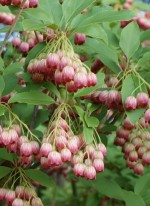 This deciduous upright shrub is a native of Japan where it grows in open woodlands offering three seasons of beauty. In spring, it produces pendulous clusters of delicate bell-shaped yellowish flowers with red veins that resemble those of Pieris. During the summer months the leaves are medium green to bluish green and are borne in clusters at the tips of the branches and in fall turn yellow, orange, or red depending on the individual plant. Since the fall color is variable buying a specimen in autumn is the best way to ensure getting the color you want. A member of the Heath family (Ericacea), redvein enkianthus likes moist, well-drained acidic soil and is especially attractive growing on woodland edges with other family members like rhododendrons. It can also be trained as a small tree and is attractive planted in small groups, as a specimen, or in a border. Site it close to an entryway or outdoor living space so you can enjoy the delicacy of the flowers. Flowers last a long time in arrangements. The genus name, Enkianthus, comes from the Greek words enkyos, meaning pregnant and anthos meaning flower, and refers to the swelling at the base of the corolla of some species. The specific epithet, campanulatus, is the diminative of the Latin word campana, meaning bell, and refers to the form of the flowers.
This deciduous upright shrub is a native of Japan where it grows in open woodlands offering three seasons of beauty. In spring, it produces pendulous clusters of delicate bell-shaped yellowish flowers with red veins that resemble those of Pieris. During the summer months the leaves are medium green to bluish green and are borne in clusters at the tips of the branches and in fall turn yellow, orange, or red depending on the individual plant. Since the fall color is variable buying a specimen in autumn is the best way to ensure getting the color you want. A member of the Heath family (Ericacea), redvein enkianthus likes moist, well-drained acidic soil and is especially attractive growing on woodland edges with other family members like rhododendrons. It can also be trained as a small tree and is attractive planted in small groups, as a specimen, or in a border. Site it close to an entryway or outdoor living space so you can enjoy the delicacy of the flowers. Flowers last a long time in arrangements. The genus name, Enkianthus, comes from the Greek words enkyos, meaning pregnant and anthos meaning flower, and refers to the swelling at the base of the corolla of some species. The specific epithet, campanulatus, is the diminative of the Latin word campana, meaning bell, and refers to the form of the flowers.
Type: Deciduous flowering shrub or small tree
Outstanding Features: Flowers in spring; fall coloration
Form: Upright, somewhat open at base
Growth Rate: Slow
Bloom: Pendulous clusters of bell-shaped yellowish flowers with red veins in spring
Size: 6-12’ H x 4-6’ W
Light: Full sun to partial shade
Soil: Average, medium moist, well-drained, acidic
Hardiness: Zones 5-8
Care: Does not need pruning
Pests and Diseases: Generally disease and pest resistant; spider mites can be a problem in hot climates
Propagation: Seed; soft-wood cuttings
Outstanding Selections:

-
- ‘Red Bells’ (intense flower color; good fall color)

- ‘Albiflorus’ (creamy white flowers without red veins; orange-red fall color; compact).
